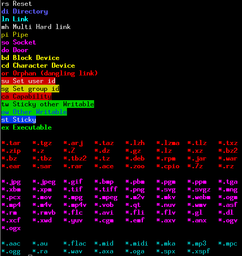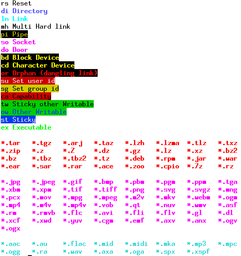

| Foreground | Background | File type |
|---|---|---|
| Bright Blue | Default | Directory |
| Bright Cyan | Default | Link |
| Default | Default | Regular file or Multi hard link |
| Dark Yellow or Brown | Black | Fifo / Pipe |
| Bright Magenta | Default | Socket or Door |
| Bright Yellow | Black | Block Device or Character Device |
| Bright Red | Black | Dangling link |
| Foreground | Background | Perms |
|---|---|---|
| White | Red | Set user ID |
| Black | Yellow | Set group ID |
| Black | Red | Capability |
| Black | Green | Sticky other Writable |
| White | Green | Other Writable |
| White | Blue | Sticky |
| Bright Green | Default | Executable |
| Foreground | Background | Ext |
|---|---|---|
| Bright Red | Default | Compressed |
| Bright Magenta | Default | Video |
| Cyan | Default | Audio |
On a black background, blue tends to be too dark. Not just in ls-colors but in
vi as well. On a white background green, cyan and yellow are way too bright.
I use xterm in boldColors mode with a black background and a grey foreground;
xterm -pc -bg black -fg grey90 -fn -misc-fixed-medium-r-normal--20-200-75-75-c-100-iso10646-1 -fs 12
This will set the default font to bitmap. With a Ctrl - right mouse click
monospace TTF can be selected.
Bold is dispayed as high intensity.
I made a .Xresources file with a statement to make blue a bit brighter;
*VT100*color4: rgb:00/44/ee
Run xrdb to enable the new colour;
~$ xrdb -merge ~/.Xresources
Any new instance of xterm will now use a brighter shade of blue.
You can use a simular trick to change dark yellow into brown if you like.